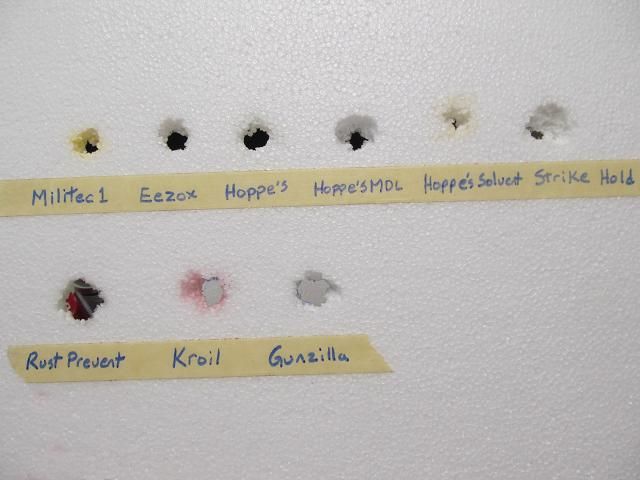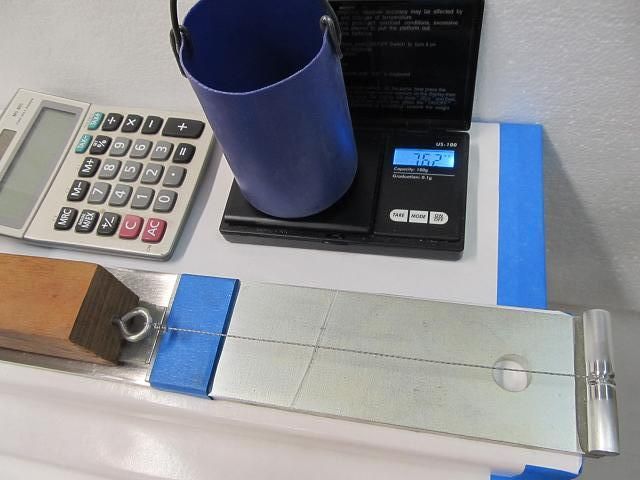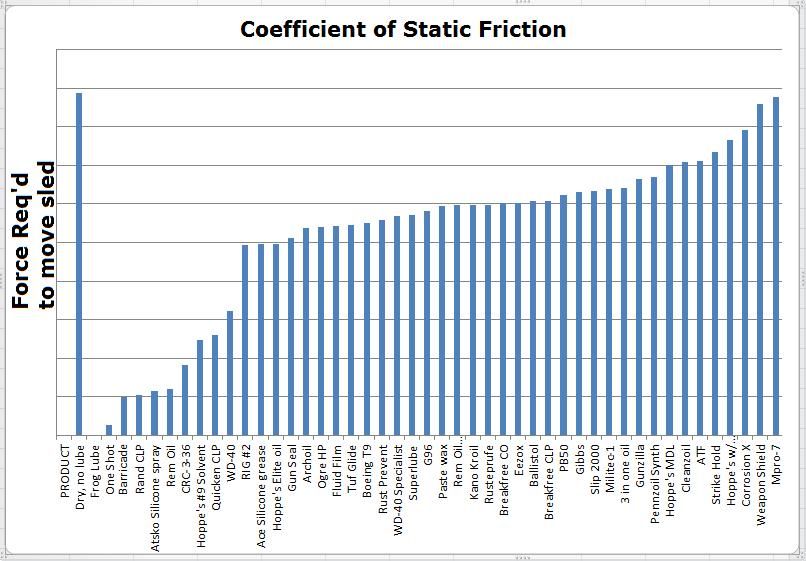Compatability:
Next up is evaluating compatibility with non-metal compounds. This is a tough claim to challenge since there are more plastic and rubber compounds and types of finishes than anybody could possibly check. Some products clearly stated they are not safe for rubber or plastic or finishes and cautioned the user to first test on a discrete location. Other products stated they are safe for (or outright encouraged use) on finishes, leather, wood, etc while still others made no warning nor statement in this regard. A simple check for reaction is to place a small amount of each product on polystyrene (Styrofoam) and observe the reaction. We know what Gas and Acetone do to Styrofoam and we wouldn’t use those harsh products on our gun finish or plastics or rubber so I will use that as a base for this evaluation. Compounds known to destroy polystyrene are Gasoline, Benzene, Toluene, Acetone, Xylene. There are other agents harmful to polystyrene but you get the point. Since its not practical to do a compatibility evaluation with every known type of plastic and every type of gun finish and paint, I only tested polystyrene and took the warnings about compatibility from the product labels.
The majority of the products did not harm nor soften polystyrene. Here is the sheet I used for the evaluation.

Here is an easier to read image of the products in this evaluation that dissolved polystyrene. It should be noted that all 3 water displacers were harmful to the evaluation sheet of polystyrene yet 6 other products that were not water displacers were also harmful to the sheet.

lubrication:
The reduction of friction/heat in moving metal parts is what I evaluated next. Many of the products make claims in regards to lubrication meaning a reduction in friction/heat/wear. (some make fantastic claims) To evaluate lubrication claims I will evaluate static friction forces. If you slept through your science/physics classes, Static Friction is the force that resists the movement of two objects against one another when the objects are initially at rest. To evaluate the lubrication claims I made a simple device to evaluate static friction forces. Two polished steel surfaces are used to mimic firearms parts. Its size and length of travel was meant to mimic the travel of the action of your typical firearm. A force is applied to cause the weighted steel sled to begin moving on a steel track. Increasing amounts of water are added to a container that is tethered to the weighted sled until the weight is great enough to overcome friction and move the sled. The weight of that water will be recorded to establish a factor compared to dry steel against dry steel.
To establish a baseline value for two dry steel surfaces, the exercise was repeated 8 times and then an average was established. Each product will be evaluated by applying the product to both surfaces and recording the amount of weight (force) required to get the weighted sled to move and then repeating the exercise 8 times to arrive at an average force.
Here are a few photos of the device used to capture static friction forces.





Here is a brief video of the device in action. (note that in an effort to make the video as short as possible I poured the water faster then I will during the actual evaluation)
https://www.youtube.com/watch?v=Nfdn5OuL8TY
How much lube to use:
We have all been instructed to apply lubrication liberally and to wipe off any excess. This seems counter intuitive if you consider something like packing a wheel bearing or using a grease zerk where metal parts are suspended in a bath of lubricant. Gun parts, folding knives, fishing reels and tools however are tightly toleranced with almost no room for large volumes of lubricant but aside from space constraints, excess lubricants cause an increase in effort required to get parts moving. I’m not versed in fluid dynamics but I quickly learned what happens when too much lubricant is applied. Being curious about what I observed I took to the web to review terms such as “Cohesion”, "Adhesion", “Fluid tackiness”, "Viscosity" and "Fluid shear" which explained what I was observing.
Excess lubricant acted like a glue that slowed or resisted parts from movement because of the surface tension and viscosity of the excess lube. As I removed more and more of the excess, I observed that less force was required to overcome static friction. In almost every case I found that removing all visible lubricant resulted in the lowest levels of friction between the two polished steel plates. What we have been told is correct, apply liberally to coat and then remove all excess to the point where you think you have removed too much and you will enjoy the least amount of friction. The side benefit to that dry level of lubrication is that it will not attract foreign contaminants that could get trapped in excess/wet lubricant.
To ensure there is no cross contamination of products on the sled/track device, after each product is evaluated, the sled and track are cleaned with acetone and paper towels until the dry to dry friction values were restored. Several dry runs are performed before the next product was evaluated.
NOTE** I recognize this evaluation may have deficiencies. My lubrication evaluation was conducted at 70 degrees F so it is unknown if the results would be the same if evaluated at 0 or 120 degrees F. Also I am not evaluating longevity. I cycled each product 8 times to arrive at an average force and understand that a product that performed well during 8 cycles may fail long term where a product that performed slightly worse may in fact have better long term lubrication. With that said, equity was my first priority. Every product and action was conducted the same way to ensure each product was getting a fair evaluation.
I recorded the results of the force required to move the sled and used a spreadsheet to tabulate the results for this chart.

To ensure that I was getting credible data and to increase my confidence level, I conducted the lubrication evaluation a 2nd time because as you can see, one product (Frog Lube) in the first evaluation reduced friction so much that I could no add water to the container. Simply hanging the empty container on the device caused the sled to move. For the 2nd evaluation I added weight to the sled and raised the end of the track to create a 10 degree upward slope meaning the sled would have to slide up-hill with the added weight. The results changed but not by much. The top 10 performers remained the top 10 and the bottom 10 remained the bottom 10. The products did jockey each other for position within their respective groups. Here is a chart showing the results from the 2nd evaluation for friction. To make it a little easier to read I am showing only the top 10 performers and the bottom 10 performers in their new rankings.
